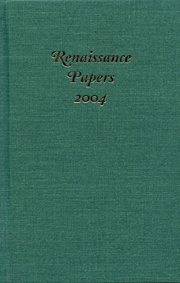Book contents
- Frontmatter
- Contents
- Renaissance Papers
- All Ovids Elegies, the Amores, and the Allusive Close of Marlowe's Hero and Leander
- Revisiting Shakespeare's Eliot
- “'Tis Rigor and Not Law”: Trials of Women as Trials of Patriarchy in The Winter's Tale
- Crossing Wits: Donne, Herbert, and Sacramental Rhetoric
- Love and Power: The Rhetorical Motives of John Donne's 1622 Sermon to the Virginia Company
- Crashaw, Catholicism, and Englishness: Defining Religious Identity
- Addendum
- Beyond “no end”: The Shape of Paradise Lost X
Crossing Wits: Donne, Herbert, and Sacramental Rhetoric
Published online by Cambridge University Press: 12 September 2012
- Frontmatter
- Contents
- Renaissance Papers
- All Ovids Elegies, the Amores, and the Allusive Close of Marlowe's Hero and Leander
- Revisiting Shakespeare's Eliot
- “'Tis Rigor and Not Law”: Trials of Women as Trials of Patriarchy in The Winter's Tale
- Crossing Wits: Donne, Herbert, and Sacramental Rhetoric
- Love and Power: The Rhetorical Motives of John Donne's 1622 Sermon to the Virginia Company
- Crashaw, Catholicism, and Englishness: Defining Religious Identity
- Addendum
- Beyond “no end”: The Shape of Paradise Lost X
Summary
The year is 1615, and Donne and Herbert, according to Isaak Walton, exchange Latin poems exploring the cross-as-anchor emblem (Donne's newly adopted crest). The cross and its attendant paradoxes offer both wits ample room to exercise their peculiar brand of virtuosity both in Latin and in their own English translations—Donne's “To Mr. George Herbert with One of My Seals of the Anchor and Christ” and Herbert's “In Sacram Anchoram Piscatoris.” Gardner refers to Herbert's contribution to this exchange as an “obscurely worded conceit,” but I am not sure Donne's is any less opaque. Both expound on just how the cross becomes an anchor for the soul, and in so doing both wits engage the relation between graphic representation (the emblem itself), language (the poesy accompanying it), and grace (the power of meaning to encourage faith). The central question implicit in both poems is to what extent can poetry, or any kind of mimesis, serve as a medium or channel for God's grace and how does it then compare with the Christian sacraments whose specific intent is to convey God's grace. I am not comfortable with Theresa DiPasquale's conclusion that, for Donne, a poem can be a sacrament in the same manner that the eucharist is. What develops in their exchange is a notion of the efficacy of figural expression, what I call “sacramental rhetoric.”
- Type
- Chapter
- Information
- Renaissance Papers 2004 , pp. 69 - 84Publisher: Boydell & BrewerPrint publication year: 2005



